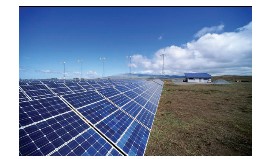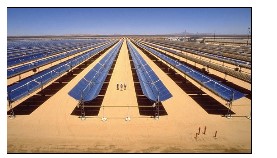
The 20th century was an era of awakening for mankind. Not only did people
realize the far reaching effects of depleting non-renewable resources for
energy generation, but also worked on harnessing renewable sources like
sunlight, wind, rain, tides and geothermal heat similar to what our early ancestors
used for energy . Studies so far show that if no action is taken in time, not only would
our future generations be without resources for energy generation but it would also
drive the planet to the brink of catastrophe.
The onus lies on us to be responsible in consumption and generation of energy.
Energy is a challenging yet growing sector which demands deft handling and a
responsibility of preserving the delicate balances created by nature. In order to
reach the levels deemed safe by the world's scientific community, carbon emissions
must decline by 5 per cent every year. Globally public policy makers and business
leaders face the critical challenge to significantly increase carbon productivity while
expanding world economy.
We strongly believe that the next couple of years will see a rise in the oil prices,
which will draw more attention to renewable energy especially solar power. The way
forward is to exploit renewable energy sources, of which solar energy is by far the
most prominent and could be used to meet global energy demand in a carbon-neutral
fashion.
Wind and solar power are the world's fastest-growing energy sources, with
capacity expanding at double-digit rates every year over the past decade.

The effects of this rapid growth include impressive technology advances, dramatic
cost reductions, and an increase in political support for renewable energy around the
world. Just as oil was a passport to wealth in the 20th century, the sun will be a
gateway to prosperity in the 21st. The reason behind the excitement about solar
power is that it offers a viable solution, at least in part, to all major challenges of
economic competitiveness, energy independence, and climate change.
Today solar power has already become a small part of daily life. From solar heated
swimming pools to solar powered homes, some examples already exist to show the
useful application of the clean, safe,
sustainable power of the sun. Yet many
wonder if small applications will be all solar
power is capable of handling. Certainly, the
difficulties of large solar plants are many,
although experts continue to insist that the
future of solar energy is quite sunny. The
future of solar energy depends mostly on how
it is applied, rather than it being enough
energy to be a viable world power source.
The sun is an inexhaustible, clean and more
importantly free energy source. What's
impeding the immediate mushrooming of
Solar Power plants is the high capital cost
involved. When you set up a solar plant, you
make an 80-90 per cent capital payment
upfront in comparison to a thermal power
plant, where the upfront capital cost is only
30 per cent of the total cost and the rest is consumed in terms of
fuel (coal) over its
lifetime. Since the fuel is
free in a solar power
plant, the only cost after
setting up a plant will go
into operations and
maintenance, which is
negligible. While, in the
long run a solar power
plant makes sense to the
environment and the
economy, the high
capital investment is a
source of bother.
Solar energy is dispersed/scattered/time sensitive/limited to
few hours a day time and intermittent, so effective storage and
distribution are critical to matching supply with demand. But
significant solar expansion also would challenge innovators to
increase grid integration capabilities, develop new energy storage
systems and upgrade solar financing mechanisms. And we would
need to train a solar workforce that can deploy and integrate solar
into existing and new infrastructure. Meeting such enormous
logistical challenges is difficult, but not impossible. This will
require more than just effective individual companies. It will
require coordination across the entire solar community, including
private companies, academia, non-profits, and government to
take our collaborative efforts to a new level. The good news is that
solar policy has made some remarkable advances in recent years,
despite the industry's limited resources. This has happened
because solar offers a real solution that speaks to today's needs in
a uniquely effective way.
For renewable energy to make a significant contribution to
economic development, job creation, reduced fossil fuel dependence,
improved human health, and lower green-house-gas
emissions, it is essential to improve the efficiency of the
technologies, reduce their costs, and develop mature, self sustaining
industries to manufacture, install, and maintain
renewable energy systems. The goal must be to establish the
conditions for sustained and profitable industries. These in turn
will boost renewable energy capacity, generation, and will drive
down costs. Viable, clear, and long-term government
commitments are critical to this end, along with policies that
create markets and ensure a fair rate of return for investors.
The future of energy is constrained by a myriad of issues
spanning growing demand, constrained supply, geopolitical
dynamics and more importantly challenged new resources. Newer
business models are required to meet the significant growth of
global energy demand. Adding & accelerating the diversification
of energy generation sources is essential. Most companies in the
solar business today understand that 'scale' is very important
more so to create a foot print. However, a key tenet for
sustainability is 'innovation'. Companies with holistic energy
strategies and newer business models are poised to succeed.
The Solar industry has seen the emergence of modular &
hybrid systems to meet customers' needs at affordable costs.
Solar Thermal (CSP) has seen a lot of companies design and
demonstrates patented technologies based on parabolic
troughs & linear
Fresnel technology.
While everyone right
now is focusing on mega
projects to overcome the
power deficit that are
plaguing India as well as
other developing
countries, we believe
that the future lies in
small, modular and
distributed power
plants, where each
community will produce
its own energy in a local
fashion, without the need for high voltage transmission lines
bringing power from large power stations from far away, wherein
a lot of power is lost on the way and wasted in the form of
transmission losses.

Responsible energy is the judicious generation as well as
utilization of sustainable and clean earth-friendly energy. For
generating green energy, there are a few renewable sources to
choose from rated according to their renewability and availability
such as solar, wind, biomass, or geothermal. On their own any of
these cannot be as effective as they can be in various
combinations. The idea is to combine indigenous renewable
resources with the most powerful source the Sun to generate
power so that we don't exhaust all our resources and have optimal
supply of power day or night.
This is where hybrid technology comes in and even offers the
best alternative. In this innovative technology, the power
generation plant operates partly on solar power and partly on a
secondary source like Natural gas, Geothermal or Bio-mass.
Hybrid solar-biomass plants are the key solutions to provide
reliable power in order for CSP technology to be lucrative and
profitable. In utilizing solar power by itself, the capacity factor is
only 15 per cent but hybrid plants can provide a capacity factor of
75 per cent along with a higher thermal efficiency.
Sujana Energy Ltd has developed this technology as few more
reasons why creating a hybrid plant compared to a standalone
solar thermal or photovoltaic plant is better are that it will
decrease CO2 emissions and amount of fossil fuel being burnt. It
will also help to meet renewable portfolio standards. The capital
cost of power generation systems can be drastically reduced along
with security of providing constant supply of power thus delivering
higher capacity factor.
To shift towards renewable power generation is a choice the
world has to make. Research will provide us with more feasible
and practical solutions on how to harness renewable energy
sources. But it is the responsibility of every inhabitant of this
planet and business leaders to consciously move towards a
greener planet while sustaining economic growth in doing so.
Making the right choice in a wide range of decisions is a tall task,
but progress in that direction is inevitable, so it's time for each one
of us to pick the baton and march ahead -responsibly.
About the author: Hari Kiran Chereddi is Managing Director,
Sujana Energy Ltd